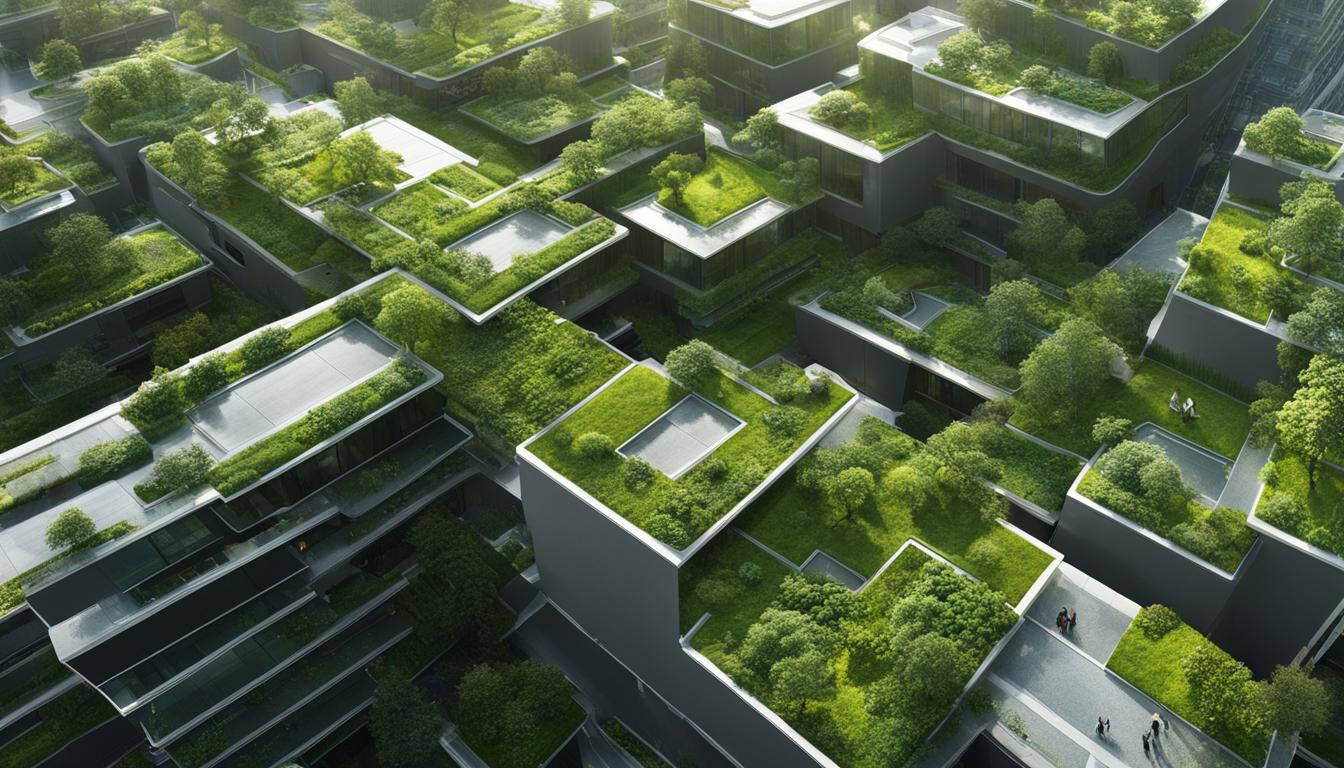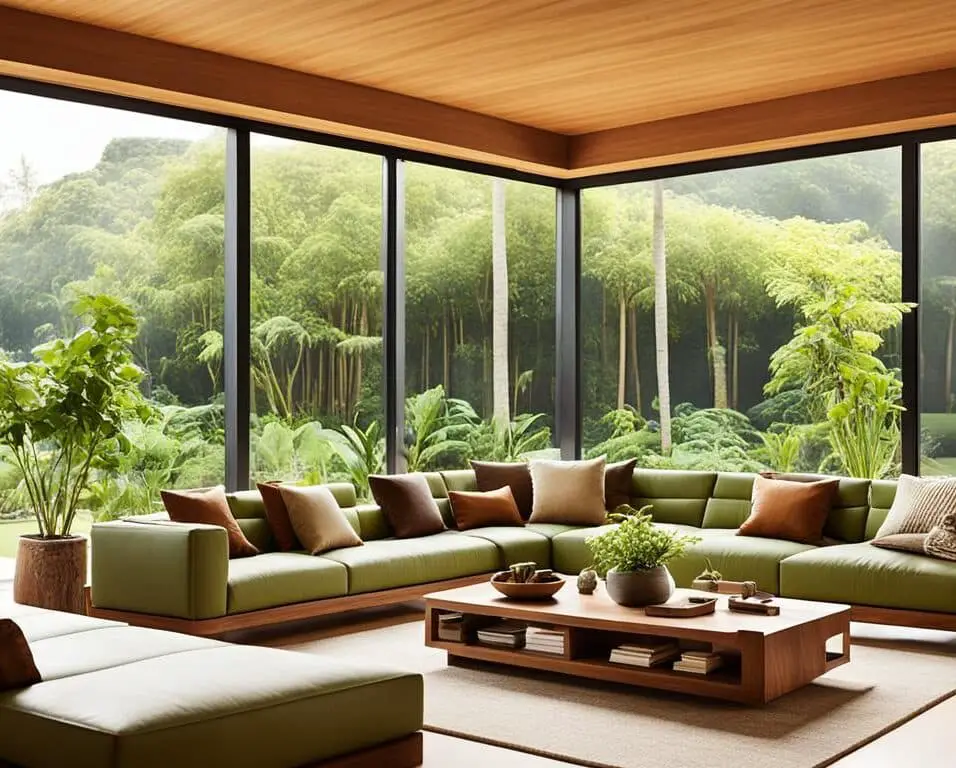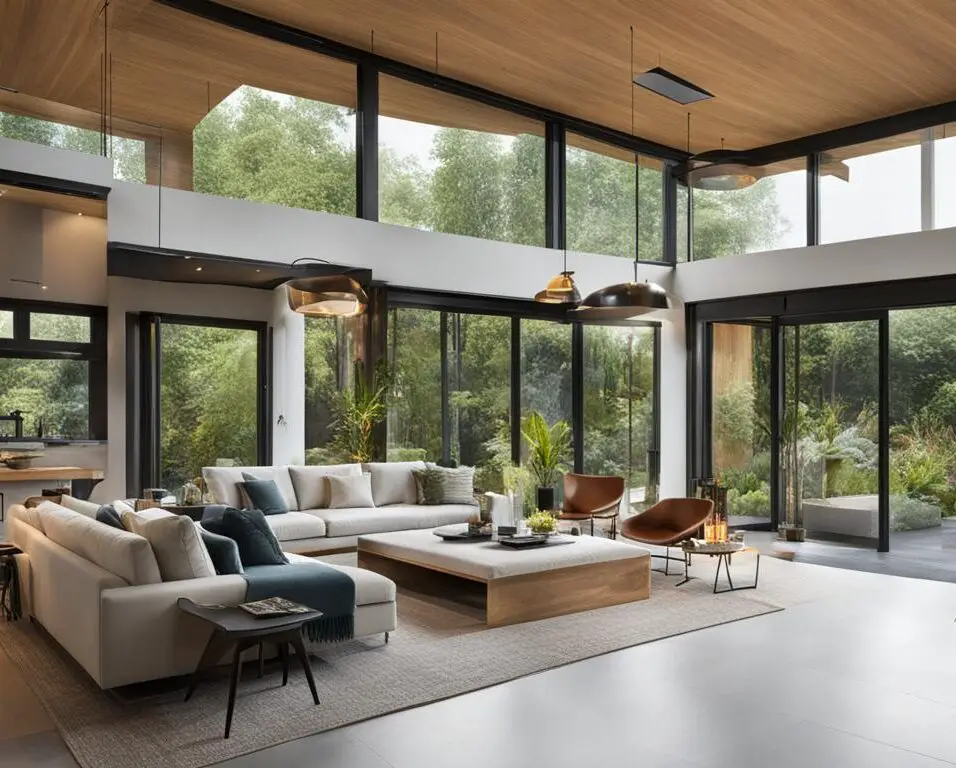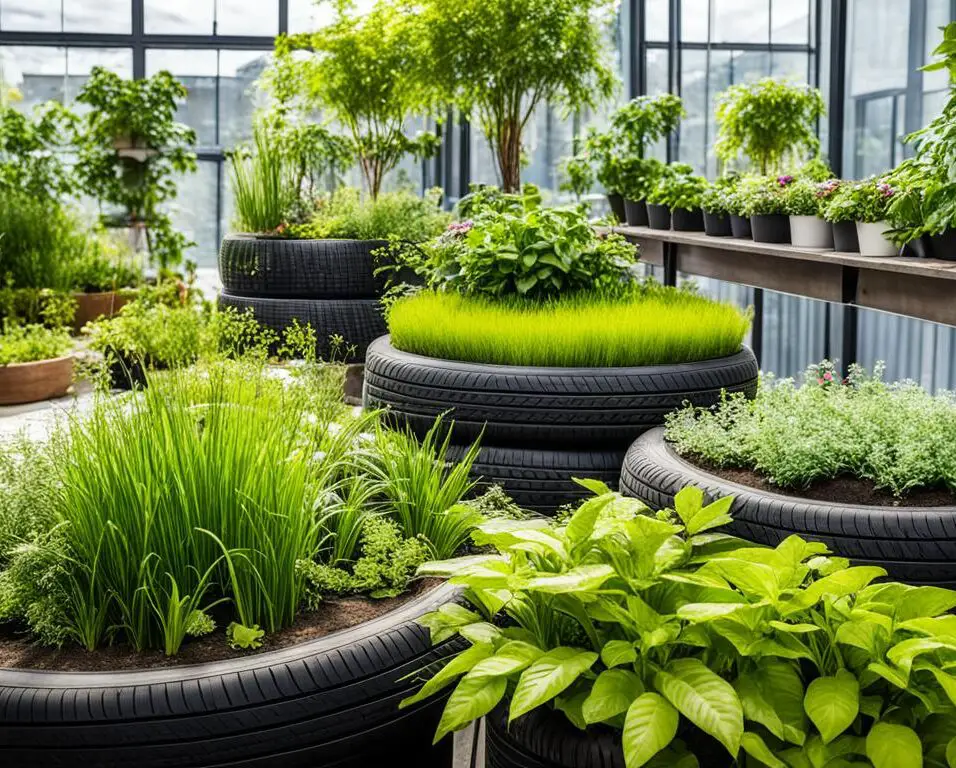Green Cityscapes: Biophilic Urban Planning for Healthier Living
As an urban planning professional, I am constantly exploring innovative ways to create healthier and more sustainable cities. One approach that has gained significant attention in recent years is biophilic urban planning. This concept recognizes the importance of incorporating nature into urban environments to improve the well-being of city dwellers and create greener, more livable spaces.
Biophilic urban planning seeks to reconnect people with the natural world by integrating elements such as green spaces, natural lighting, and water features into the urban fabric. By doing so, it aims to promote physical and mental health, reduce stress, and enhance the overall quality of life in cities. The concept of biophilic design has gained traction due to its potential to address key challenges faced by rapidly urbanizing areas, such as air pollution, noise pollution, and lack of green spaces.
Key Takeaways:
- Biophilic urban planning incorporates natural elements into urban environments for healthier living.
- Nature-inspired design can reduce stress, improve mental health, and increase productivity.
- Green spaces and natural features mitigate air and noise pollution and support biodiversity.
- Cities like Singapore, Portland, Curitiba, and Copenhagen have successfully implemented biophilic design principles.
- Embracing biophilic urban planning can create greener, healthier, and more resilient cities for the future.
Benefits of Biophilic Urban Planning
Biophilic urban planning offers numerous benefits for both individuals and communities. Research has shown that exposure to nature in urban environments can reduce stress, improve mental health, increase productivity, and promote physical activity. Green spaces and natural features also help to mitigate air and noise pollution, regulate urban temperatures, and support biodiversity. Additionally, biophilic design can enhance the aesthetic appeal of cities, making them more attractive and enjoyable places to live and visit.
“The benefits of incorporating nature into urban environments are significant. Green spaces have been shown to reduce stress and improve psychological well-being, contributing to healthier and happier communities.”
Research has shown that access to green spaces and views of nature can lower blood pressure, improve cognitive functioning, and promote faster recovery from illnesses. The presence of trees and plants in urban areas can also provide shade, lower temperatures, and reduce the heat island effect, making cities more comfortable and livable during hot summer months.
Improved Mental Health
One of the key benefits of biophilic urban planning is the positive impact on mental health. Studies have demonstrated that exposure to nature, whether it’s through parks, urban gardens, or green rooftops, can reduce symptoms of stress, anxiety, and depression. Spending time in natural environments has a restorative effect on the mind, helping to rejuvenate and improve overall well-being.
Increased Productivity
Biophilic urban planning has been linked to increased productivity in workplaces and educational settings. Incorporating natural elements such as indoor plants, natural lighting, and views of nature can enhance cognitive function, attention span, and problem-solving abilities. Employees and students in environments with biophilic design elements have shown higher levels of concentration, creativity, and job satisfaction.
Table: Benefits of Biophilic Urban Planning
| Benefit | Description |
|---|---|
| Stress Reduction | Exposure to nature in urban environments can help reduce stress levels and promote relaxation. |
| Mental Health Improvement | Biophilic design has been shown to improve mental health and well-being by reducing symptoms of anxiety and depression. |
| Increased Productivity | Natural elements in the built environment can enhance cognitive function and productivity in workplaces and educational settings. |
| Environmental Benefits | Biophilic urban planning helps mitigate air and noise pollution, regulate urban temperatures, and support biodiversity. |
| Aesthetic Appeal | Integrating nature into cities enhances their visual attractiveness and makes them more enjoyable places to live and visit. |
In addition to the individual benefits, biophilic urban planning has wider positive impacts on communities and the environment. The integration of green spaces and natural elements helps to create inclusive and sustainable cities that prioritize the well-being and quality of life of their residents. By embracing biophilic design principles, cities can build a healthier, greener, and more harmonious future for urban living.
Principles of Biophilic Urban Planning
Biophilic urban planning incorporates several key principles to create a nature-inspired urban environment. These principles are designed to maximize the benefits of integrating natural elements into the built environment, promoting sustainability, and improving the well-being of city dwellers.
Maximizing Access to Green Spaces
One of the fundamental principles of biophilic urban planning is the emphasis on maximizing access to green spaces. This includes the strategic positioning of parks, gardens, and urban forests throughout the city. By ensuring that green spaces are easily accessible to residents, cities can provide opportunities for nature exploration, recreation, and relaxation.
Integrating Natural Elements into the Built Environment
Biophilic urban planning also prioritizes the integration of natural elements into the built environment. This can be achieved through the incorporation of living walls, rooftop gardens, and green facades into buildings and infrastructure. These features not only enhance the aesthetic appeal of the cityscape but also bring the benefits of nature closer to urban dwellers.
Emphasizing Natural Lighting and Views of Nature
Natural lighting plays a crucial role in biophilic urban planning. By maximizing access to natural light and views of nature, cities can create environments that foster well-being and connection with the natural world. This can be achieved through the design of buildings that prioritize large windows, skylights, and open spaces that allow for ample sunlight and views of greenery.
Incorporating Water Features
Water features, such as ponds, fountains, and waterfalls, are another important aspect of biophilic urban planning. Incorporating water elements into urban spaces not only adds visual interest but also provides calming and soothing effects. Water features can help create a sense of tranquility and connection with nature, improving the overall experience of urban environments.
Creating a Harmonious Relationship with Nature
The ultimate goal of biophilic urban planning is to create a harmonious and sustainable relationship between people and nature in urban settings. By incorporating these principles, cities can enhance the quality of life for their residents, improve the environmental sustainability of urban areas, and create healthier and more vibrant communities.
| Principle | Description |
|---|---|
| Maximizing Access to Green Spaces | Strategic placement of parks, gardens, and urban forests throughout the city |
| Integrating Natural Elements into the Built Environment | Incorporating living walls, rooftop gardens, and green facades into buildings and infrastructure |
| Emphasizing Natural Lighting and Views of Nature | Designing buildings with large windows, skylights, and open spaces to maximize natural light and views of greenery |
| Incorporating Water Features | Adding ponds, fountains, and waterfalls to urban spaces for visual interest and calming effects |
| Creating a Harmonious Relationship with Nature | Promoting a sustainable and balanced coexistence between people and the natural environment |
Successful Examples of Biophilic Urban Planning
Many cities around the world have successfully implemented biophilic urban planning principles to enhance the well-being of their residents. These cities serve as inspiring examples of how nature can be integrated into urban environments to create healthier and more sustainable living spaces.
Singapore
In Singapore, biophilic urban planning has transformed the city into a lush urban oasis. The city is known for its extensive green infrastructure, which includes rooftop gardens, vertical greenery, and park connectors. These green spaces not only provide a peaceful retreat for the residents but also contribute to improved air quality, regulation of urban temperatures, and enhanced biodiversity. Singapore’s commitment to biophilic design has earned it the reputation of being one of the greenest cities in the world.
Portland, Oregon
Portland, Oregon, has prioritized biophilic urban planning to create a more livable city. The city’s focus on urban forests and green spaces has not only enhanced the aesthetic appeal of the city but also improved air quality and reduced the urban heat island effect. Residents of Portland can enjoy numerous parks, community gardens, and natural areas within close proximity, providing ample opportunities for recreation, relaxation, and connection with nature.
Curitiba, Brazil
Curitiba, Brazil, is celebrated for its integrated transportation and park system, showcasing the success of biophilic urban planning. The city’s efficient public transportation network is complemented by expansive green spaces, such as parks and botanical gardens, which are easily accessible to residents. This integrated approach promotes sustainable mobility and allows residents to enjoy the benefits of nature in their daily lives.
Copenhagen, Denmark
Copenhagen, Denmark, is a leading example of how biophilic urban planning can prioritize alternative modes of transportation and create pedestrian-friendly streets with green corridors. The city’s extensive cycling infrastructure and pedestrian zones encourage active modes of transportation, while the presence of green spaces along these routes enhances the well-being of residents. Copenhagen’s commitment to biophilic design has not only created a healthier and more sustainable city but also established it as one of the most bike-friendly cities in the world.
These successful examples demonstrate the positive impact of biophilic urban planning on the well-being of city dwellers. By incorporating nature into the fabric of urban environments, these cities have created greener, healthier, and more livable spaces for their residents to thrive in.
| City | Key Features |
|---|---|
| Singapore | Rooftop gardens, vertical greenery, park connectors |
| Portland, Oregon | Urban forests, green spaces, parks |
| Curitiba, Brazil | Integrated transportation and park system |
| Copenhagen, Denmark | Cycling infrastructure, pedestrian-friendly streets, green corridors |
To visually appreciate the integration of nature in urban environments, take a moment to explore this image:
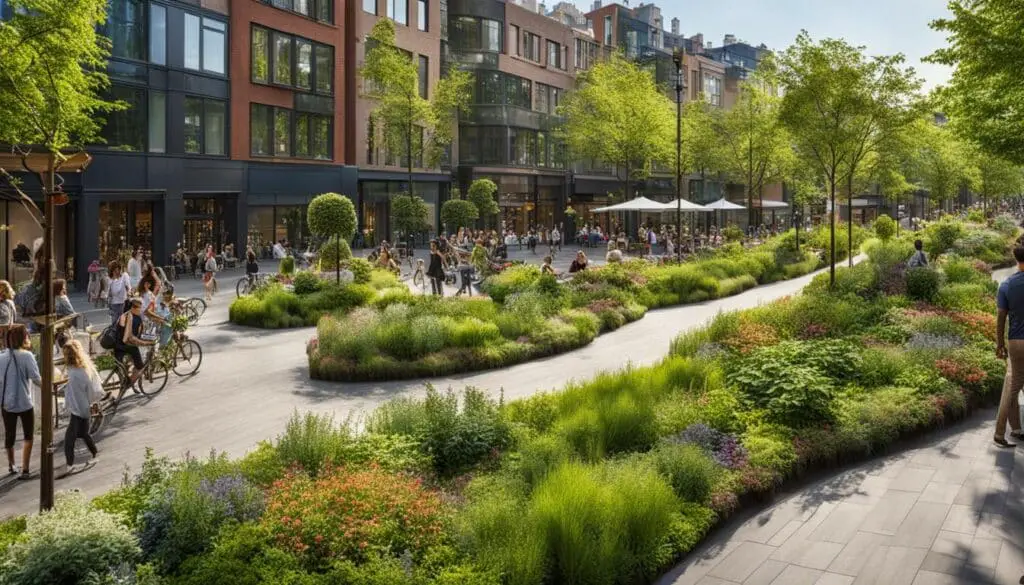
Conclusion
Biophilic urban planning offers a promising approach to creating healthier and more sustainable cities. By integrating natural elements into the urban fabric, cities can improve the well-being of their residents, mitigate environmental challenges, and enhance the overall livability of urban spaces. The incorporation of green spaces, natural lighting, and water features not only beautifies the cityscape but also provides numerous physical and mental health benefits to its inhabitants.
Studies have shown that access to nature in urban environments reduces stress levels, boosts mental health, and increases productivity. Additionally, green spaces help combat air and noise pollution, regulate urban temperatures, and promote physical activity. By adhering to the principles of biophilic design, cities can create harmonious relationships between people and the natural world, resulting in healthier and happier communities.
As urban areas continue to grow and face increasing challenges, embracing biophilic design principles becomes even more crucial. By prioritizing the integration of nature into city planning, we can create greener, healthier, and more resilient cities for the future. Biophilic urban planning holds the key to building sustainable environments that not only benefit individuals but also contribute to the overall well-being and prosperity of our communities.
FAQ
What is biophilic urban planning?
Biophilic urban planning is a concept that focuses on incorporating natural elements into urban environments to create healthier and more sustainable cities. It aims to improve the well-being of city dwellers by integrating nature, such as green spaces, natural lighting, and water features, into the urban fabric.
What are the benefits of biophilic urban planning?
Research has shown that exposure to nature in urban environments can reduce stress, improve mental health, increase productivity, and promote physical activity. Green spaces and natural features also help to mitigate air and noise pollution, regulate urban temperatures, and support biodiversity.
What are the principles of biophilic urban planning?
The principles of biophilic urban planning include maximizing access to green spaces, integrating natural elements into the built environment through the use of living walls, rooftop gardens, and green facades, and considering the importance of natural lighting, views of nature, and the incorporation of water features.
Are there any successful examples of biophilic urban planning?
Yes, there are many cities around the world that have successfully implemented biophilic urban planning principles. Examples include Singapore with its extensive green infrastructure, Portland with its urban forests and green spaces, Curitiba with its integrated transportation and park system, and Copenhagen with its cycling and pedestrian-friendly streets with green corridors.
Why is biophilic urban planning important for creating healthier cities?
Biophilic urban planning is important for creating healthier cities because it improves the well-being of residents, mitigates environmental challenges, and enhances the livability of urban spaces. By integrating natural elements into the urban fabric, cities can create greener, healthier, and more resilient environments for their residents.



